Welcome to our comprehensive guide on the top shrubs for shade gardens in Zone 9. Whether you’re seeking vibrant blooms, lush foliage, or year-round interest, we’ve got you covered.
This article showcases the finest 19 shrub varieties that thrive in shady conditions, ensuring a stunning and thriving garden all season long.
1. Common Camellia
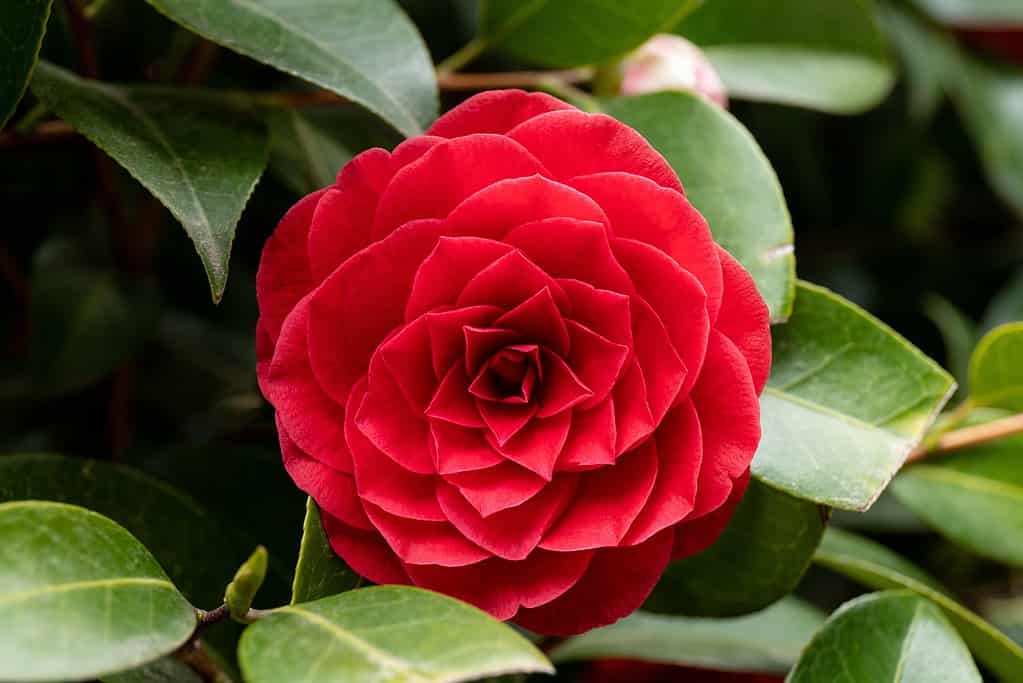
Red or pink camellias thrive in Zone 9 shade gardens.
©Olga_Shestakova/Shutterstock.com
Common camellias (Camellia japonica) are evergreen shrubs that thrive in USDA hardiness zones 7-9. This shrub prefers partial shade to full shade and will do best when planted in well-draining, acidic soil. It requires a moderate amount of water and does not tolerate drought conditions. Provide organic matter such as compost or manure to the soil for better nutrient availability. Prune annually after flowering is complete to keep the plant healthy and maintain its shape.
2. Oakleaf Hydrangea
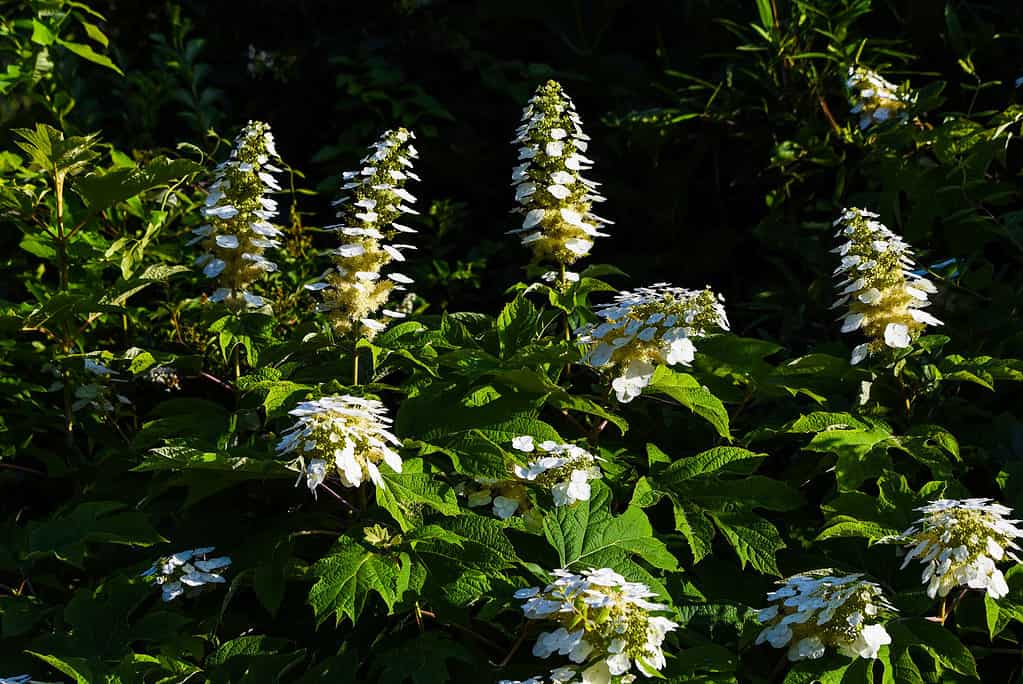
The oakleaf hydrangea is often called oak-leaved hydrangea.
©iStock.com/undefined undefined
Oakleaf Hydrangea (Hydrangea quercifolia) is an attractive, deciduous shrub that grows best in USDA hardiness zones 5-9. This plant thrives in partial to full shade and prefers well-draining soil with a slightly acidic pH level. Oakleaf hydrangeas require moderate watering during the growing season but can tolerate occasional drought conditions. Mulching around the root zone helps keep moisture levels consistent throughout the year and keeps weeds at bay.
3. Croton
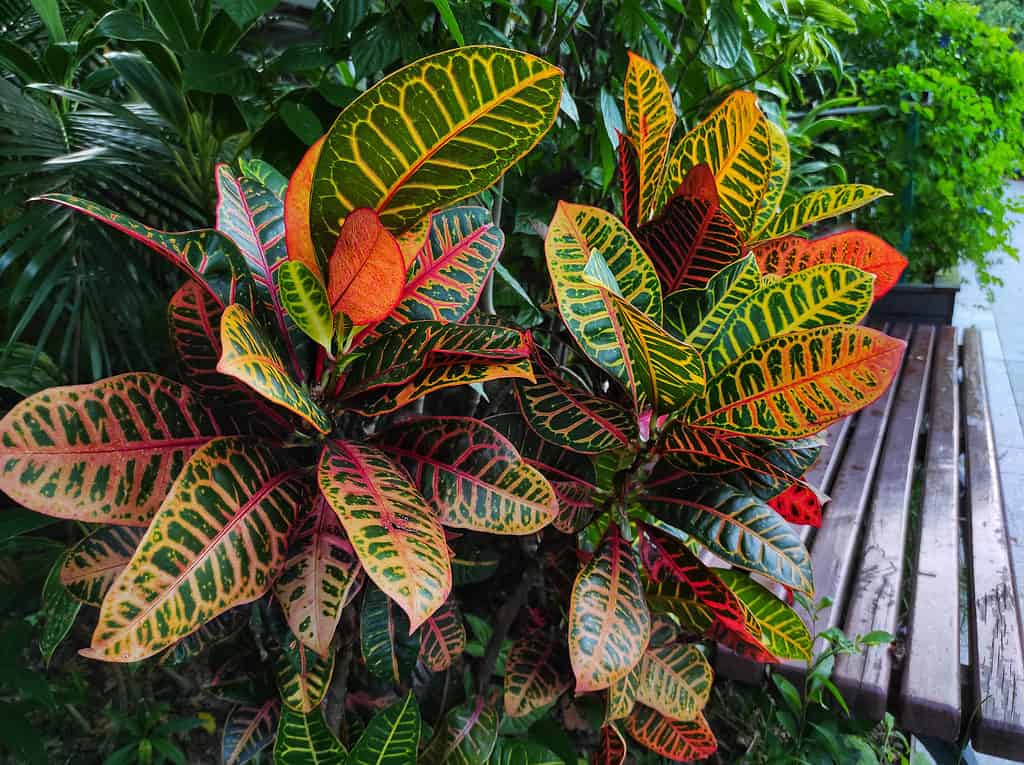
Despite their tropical colors, you can grow crotons in the shade.
©iStock.com/Hanna Yohanna
Croton (Codiaeum variegatum) is an evergreen shrub that thrives in USDA hardiness zones 9-11. It requires partial shade to partial sun and prefers well-draining soil with a pH level between 4.5 and 6.5. During the growing season, it needs moderate watering but can tolerate occasional drought conditions. Additionally, mulching around the root zone helps keep moisture levels consistent and prevents weed growth. Finally, pruning annually after flowering is complete helps maintain its shape and encourages new growth.
4. Flowering Quince
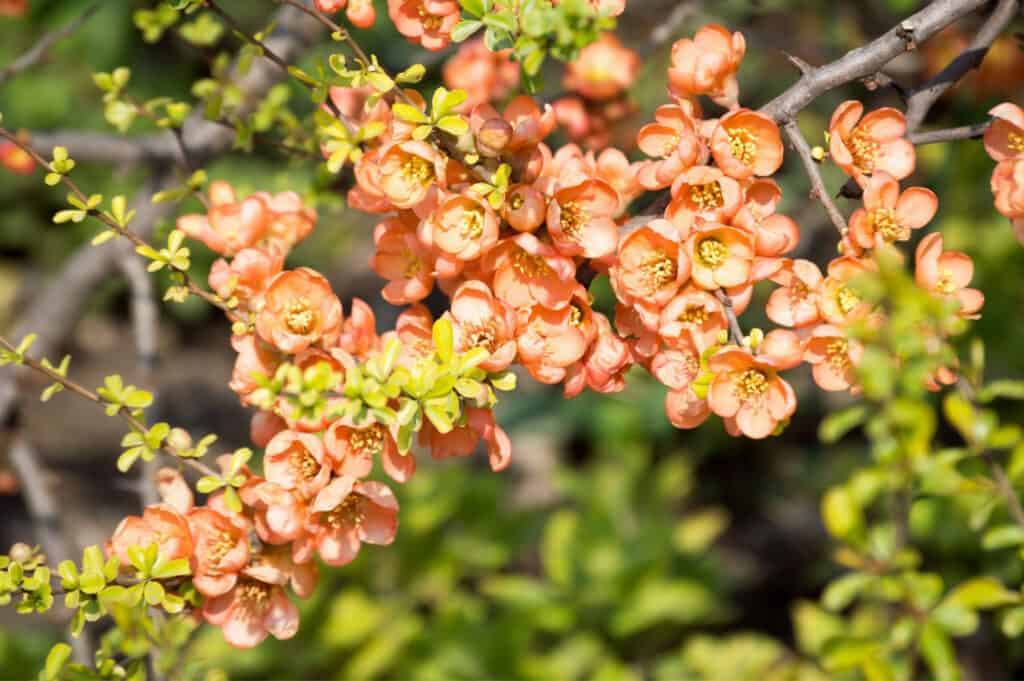
You can find flowering quince shrubs in pink, red, and orange.
©irisff/Shutterstock.com
Flowering quince is an easy-to-grow shrub that thrives in USDA hardiness zones 5-9. This plant prefers full to partial shade and well-draining soil with a slightly alkaline pH level. During the growing season, it needs moderate watering but can tolerate occasional drought conditions. Mulching around the root zone helps keep moisture levels consistent throughout the year and keeps weeds from growing too close to the plant. This is a great shrub for a zone 9 shade garden and is also called Japanese quince.
5. Bolivian Fuchsia

A vibrant red Fuchsia boliviana flower is a beautiful shrub for a Zone 9 shade garden.
©Wirestock/iStock via Getty Images
Bolivian fuchsia is a great choice of shrub for zone 9 shade gardens due to its ability to thrive in partial sunlight and tolerate occasional drought conditions. During the growing season, this shrub prefers well-draining soil with a soil pH level of 6.0 and does best when planted in an area that receives morning sun and afternoon shade. It should be watered moderately but can handle periods of dryness without issue. It grows 11-15 feet tall.
6. Coral Bells

The dainty shrub called Coral Bells, also called Alumroot has colorful flowers and colorful leaves.
©iStock.com/Martina Unbehauen
Coral bells are an easy-to-grow shrub that thrives in USDA hardiness zones 5-9. This plant prefers full to partial shade and well-draining soil with a neutral pH level. During the growing season, it needs moderate watering but can tolerate occasional drought conditions. They are a shrub that grows in a compact mounding shape and reach 16 inches tall and three feet wide. They have beautiful flower spikes that are 12-36 inches tall.
7. Plum Yew Pine

Yew plum pine, or Podocarpus macrophyllus, makes a lovely hedge or shrub in Zone 9 shade.
©undefined undefined/iStock via Getty Images
Plum yews are a great choice for Zone 9 shade gardens due to their tolerance of partial sunlight or full shade. This shrub needs well-draining soil and should be watered moderately during the growing season. It can reach heights of eight to twelve feet tall, making it an excellent choice as an evergreen backdrop or privacy screen. Plum yew pines also have attractive foliage that provides year-round interest in your garden.
8. Virginia Sweetspire
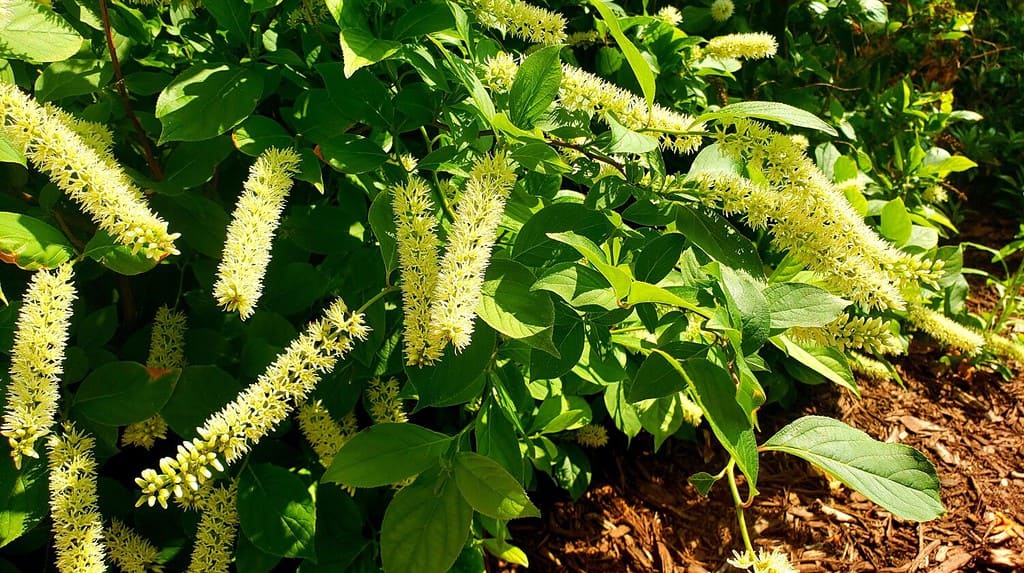
If you need a shrub for Zone 9 shade, the sweetspire is an excellent choice.
©Kazol Anthony Das/Shutterstock.com
Virginia sweetspire is a deciduous shrub that thrives in USDA hardiness zones 5-9. This plant prefers full to partial shade and well-draining soil with plenty of organic material. It needs moderate watering during the growing season but can tolerate occasional drought conditions. Virginia sweetspire grows in an upright mounding shape, reaching heights of four to eight feet tall and three to five feet wide at maturity. In late spring or early summer, it blooms small white flowers that look like long bottlebrushes.
9. Mountain Sweetbox
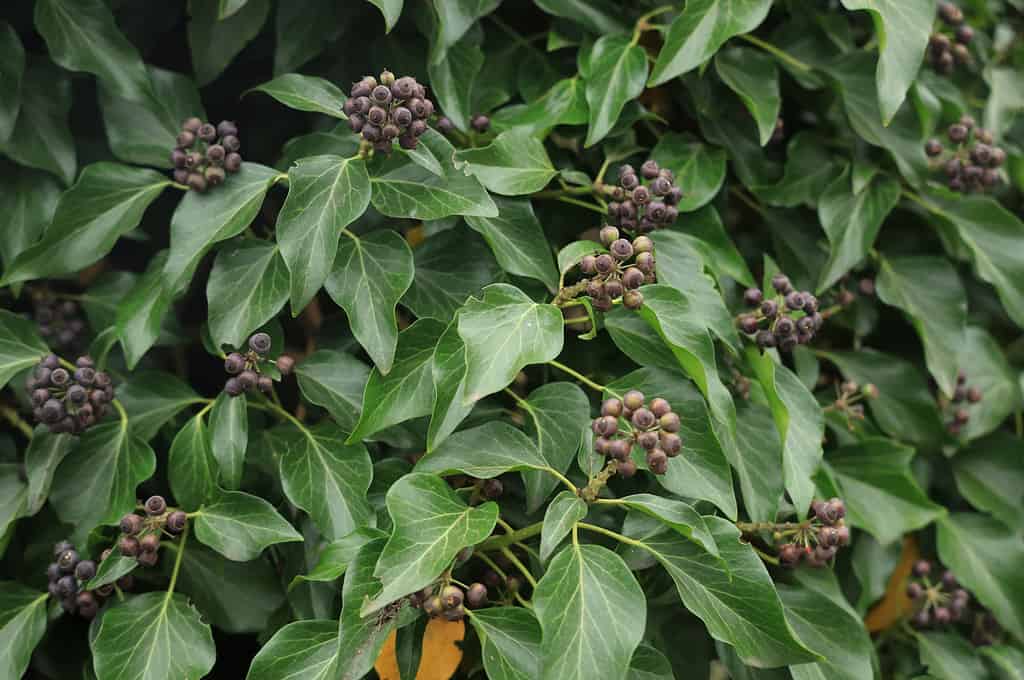
An evergreen Sweet Box Shrub (Sarcococca hookeriana) has flowers in the winter.
©maxerialarts/iStock via Getty Images
Mountain Sweetbox (Sarcococca hookeriana) is an evergreen shrub that thrives in USDA hardiness zones 7-9. It prefers partial to full shade and moist soil. Mountain Sweetbox can reach heights of up to four feet tall and three feet wide at maturity. Its glossy green foliage provides year-round interest in your garden, while its fragrant white flowers bloom from winter into spring. This plant needs moderate watering during the growing season but should not be kept soggy.
10. Mexican Bush Sage

Several different types of sage thrive in Zone 9, but bush sage is best for the shade.
©Beach Creatives/Shutterstock.com
Mexican Bush Sage (Salvia leucantha) is a perennial shrub that thrives in USDA hardiness zones 8-11 and can be grown as an annual in other zones. This plant prefers partial to full shade and is very adaptable to soil pH levels. Mexican Bush sage grows up to four feet tall and three feet wide at maturity, producing clusters of white flowers from late summer into fall, which attract butterflies and hummingbirds.
11. Climbing Hydrangea
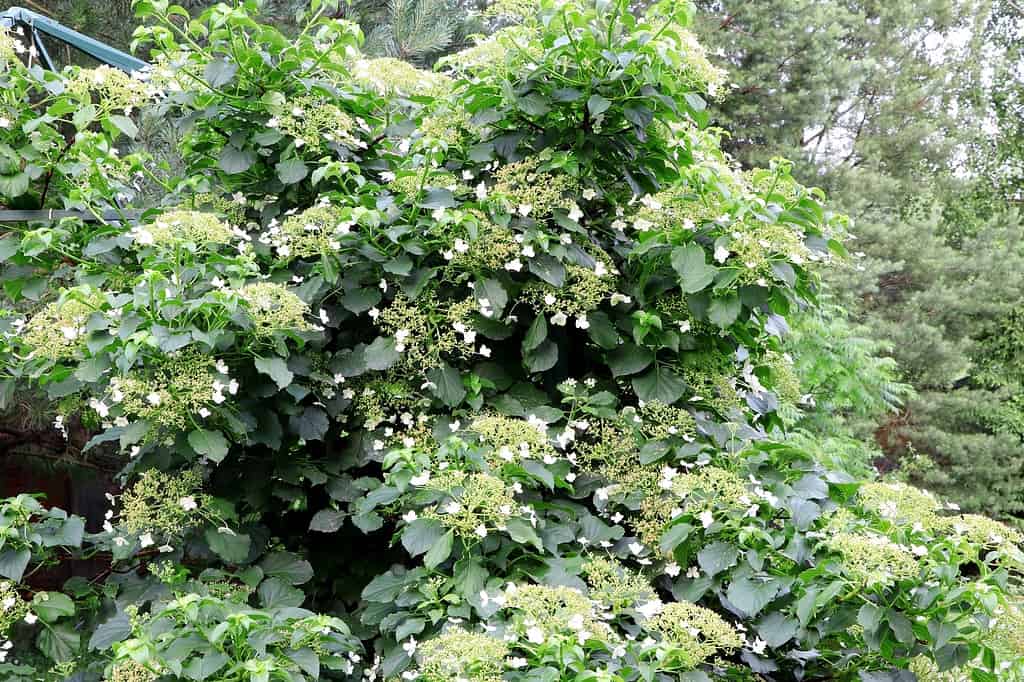
This deciduous shrub can reach heights of 30 feet!
©Mikhail Kolomiets/ via Getty Images
Climbing Hydrangea (Hydrangea anomala petiolaris) is a deciduous shrub that thrives in USDA hardiness zones 4-8. It prefers partial to full shade and moist, acidic soil with good drainage. Climbing Hydrangea can reach heights of up to 30 feet tall and spreads between 10-15 feet wide at maturity. Its large white flowers bloom from late spring into early summer and are a favorite with bees and butterflies.
12. Buttonbush

Flowering buttonbush, button-willow, or honey-bells (Cephalanthus occidentalis) is a
butterfly
favorite.
©Kristine Radkovska/iStock via Getty Images
Buttonbush (Cephalanthus occidentalis) is a deciduous shrub that thrives in USDA hardiness zones 4-10. It prefers partial to full shade and moist, well-drained soil with an acidic pH level between 6.8 to 7.2. Buttonbush grows up to twelve feet tall and wide at maturity, producing white flowers from late spring into early summer, which attract butterflies and hummingbirds. This plant needs moderate watering during the growing season but should not be kept saturated.
13. David Viburnum
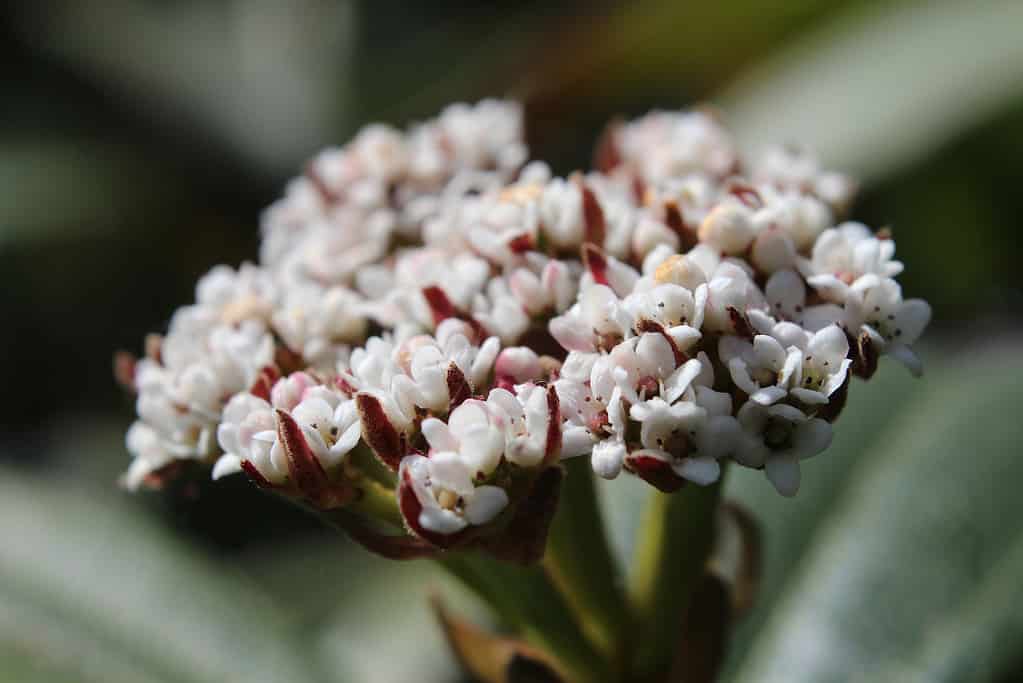
The lovely tiny white flowers of Viburnum davidii are a bee’s favorite snack.
©Imladris01/iStock via Getty Images
David Viburnum (Viburnum davidii) is a deciduous shrub that thrives in USDA hardiness zones 6-9. It prefers partial to full shade and moist, acidic soil with good drainage. David Viburnum can reach heights of up to 3 feet tall and spreads between 3-4 feet wide at maturity. Its white flowers bloom from late spring into early summer, which attracts butterflies and hummingbirds.
14. Chinese Wild Ginger
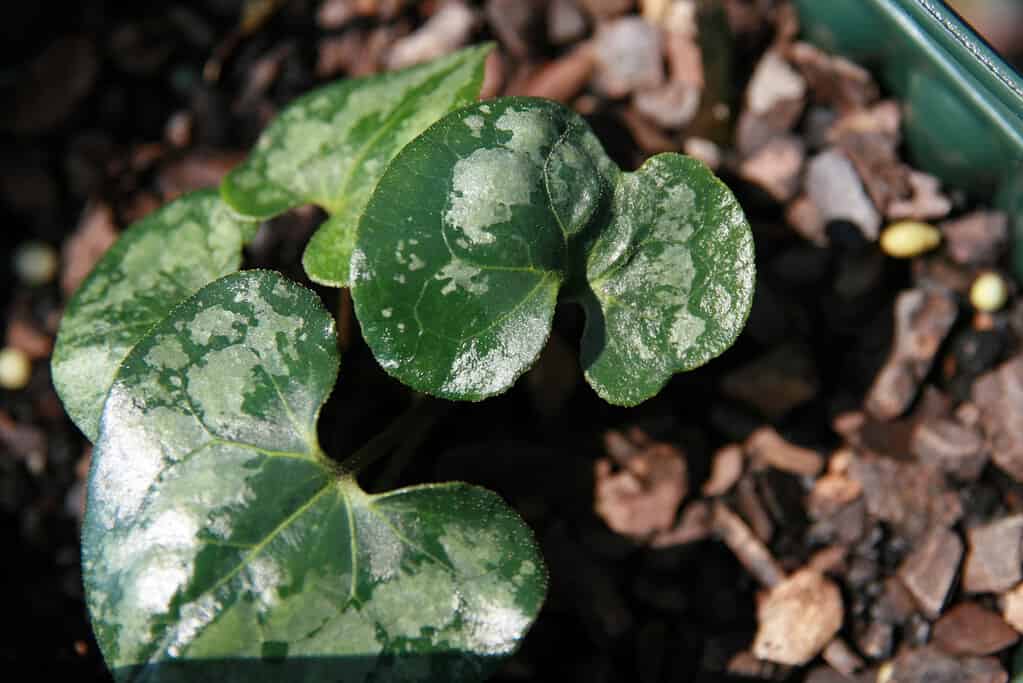
A great choice for deep Zone 9 shade is Chinese wild ginger.
©Photo by David J. Stang, CC BY-SA 4.0 – License
Chinese Wild Ginger (Asarum splendens) is a perennial evergreen plant that thrives in USDA hardiness zones 5-9. It prefers partial to full shade and moist, well-drained soil with a soil pH below 6.0. Chinese Wild Ginger can reach heights of up to 8 inches tall and spreads between 12-18 inches wide at maturity. This plant likes to be consistently moist and is not drought-tolerant.
15. Flowering Currant Bush
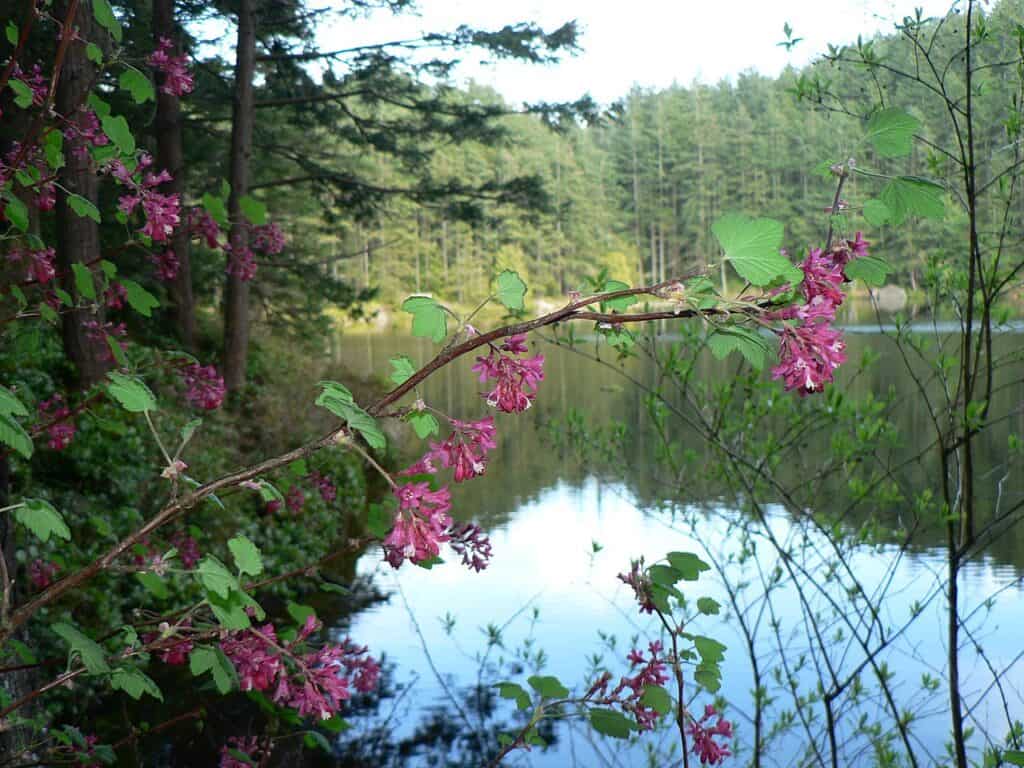
Ribes sanguineum, or flowering currant bush, thrives in Zone 9 shade gardens.
©Walter Siegmund / CC BY-SA 3.0, , via Wikimedia Commons – License
Flowering currant bush (Ribes sanguineum) is a deciduous shrub that thrives in USDA hardiness zones 6-9. It prefers partial to full shade and moist, well-drained soil with any pH level. Flowering currant bush can reach heights of up to 5-9 feet tall and spreads between 4-6 feet wide at maturity. Its pink flowers bloom in April and May and attract pollinators. The berries are edible but lack intense flavor and are mildly peppery tasting.
16. Evergreen Currant Bush
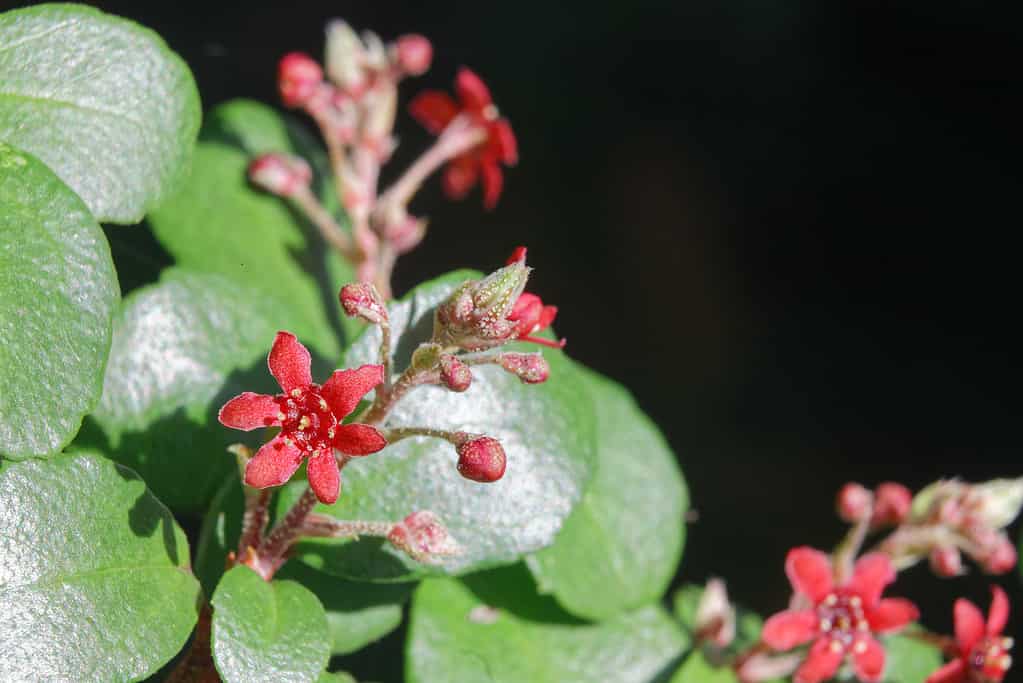
Ribes viburnifolium (evergreen currant) flowers attract pollinators.
©Wirestock/iStock via Getty Images
The evergreen currant bush (Ribes viburnifolium) is a drought-tolerant evergreen shrub that thrives in USDA hardiness zones 8-11. It prefers partial to full shade and moist, well-drained soil with any pH level. Evergreen currant bush can reach heights of up to 4 feet tall and spreads between 4-6 feet wide at maturity. Its fragrant, leathery leaves arch outward from the center of the shrub. It has dusty pink flowers in the late winter that are shaped like stars and last until the middle of spring.
17. Manzanita

The flowers of many types of manzanita plants are edible.
©iDiscoverer/Shutterstock.com
Manzanita (Arctostaphylos sp.) is an evergreen shrub that thrives in USDA hardiness zones 8-10. It prefers partial to full shade and well-drained soil with any pH level between 3-7. Manzanita can reach heights of up to 10 feet tall and spreads between 8-12 feet wide at maturity. Its glossy, dark green leaves contrast against its reddish bark, which gives the plant a unique look. In springtime, small white flowers bloom on the plant that you can eat.
18. Boxwood

If you need a shrub for Zone 9 shade, the boxwood will grow in either shade or part sun.
©iStock.com/Yarygin
Boxwood (Buxus sp.) is a versatile evergreen shrub that thrives in USDA hardiness zones 5-9. It prefers partial to full shade and well-drained soil with a pH level between 6.5 and 7.0. Boxwood can reach heights of up to 20 feet tall and spreads between 3-8 feet wide at maturity. Its dense, glossy green leaves are used for hedging or topiary work due to its ability to be pruned into shapes easily. With proper care, boxwoods can last for hundreds of years.
19. Euonymus

There are several cultivars of Euonymus shrubs that grow in Zone 9 shade.
©anmbph/Shutterstock.com
Euonymus (Euonymus spp.) is an evergreen shrub that thrives in USDA hardiness zones 5-9. It prefers partial to full shade and any soil type with plenty of organic matter. Euonymus can reach heights of up to 15 feet tall and spreads between 3-8 feet wide at maturity. Its glossy green leaves turn reddish or yellow during the fall months, adding interest throughout the season.
The photo featured at the top of this post is © Imladris01/iStock via Getty Images
Thank you for reading! Have some feedback for us? Contact the AZ Animals editorial team.






